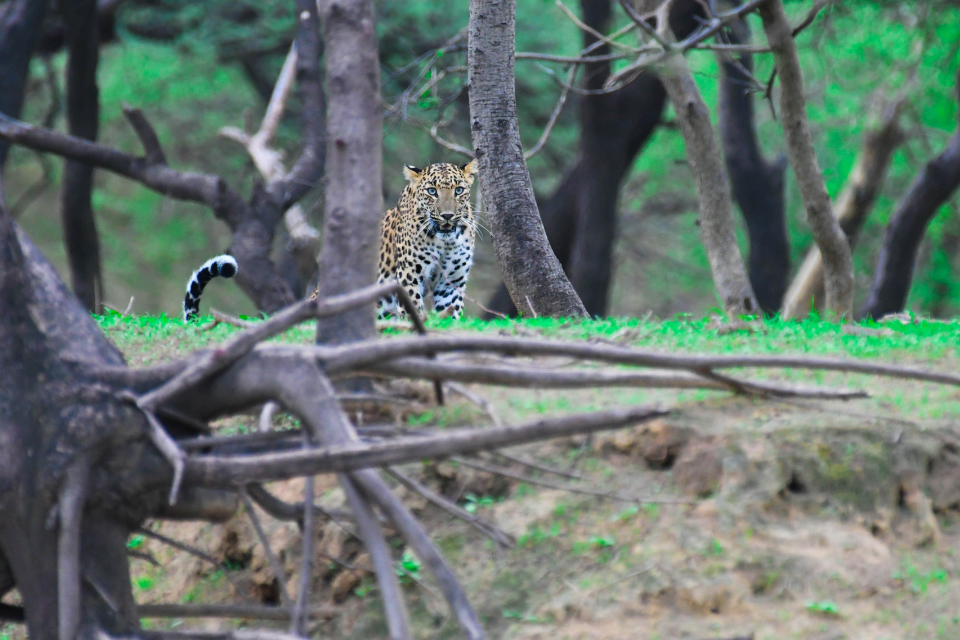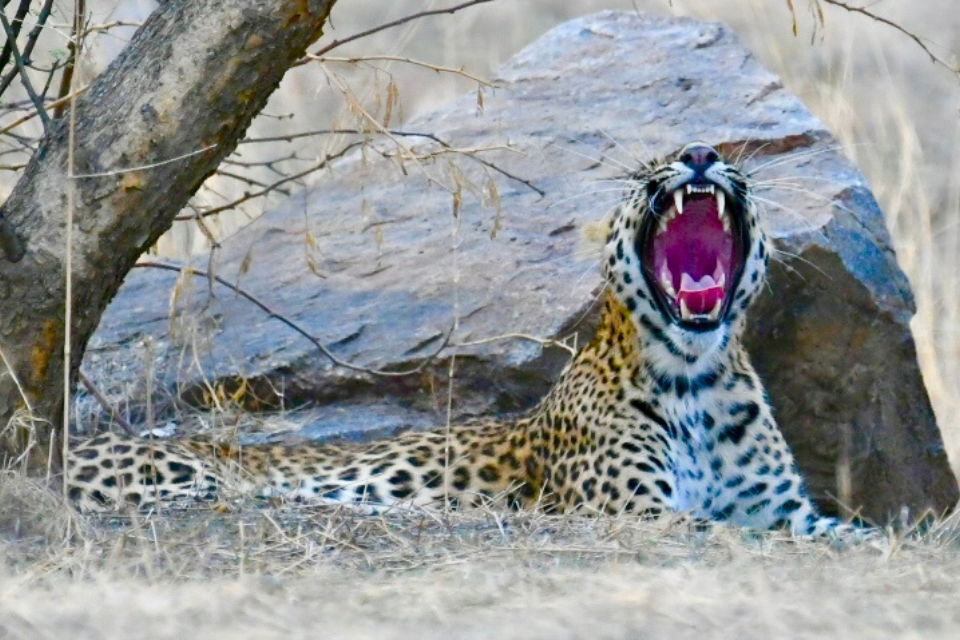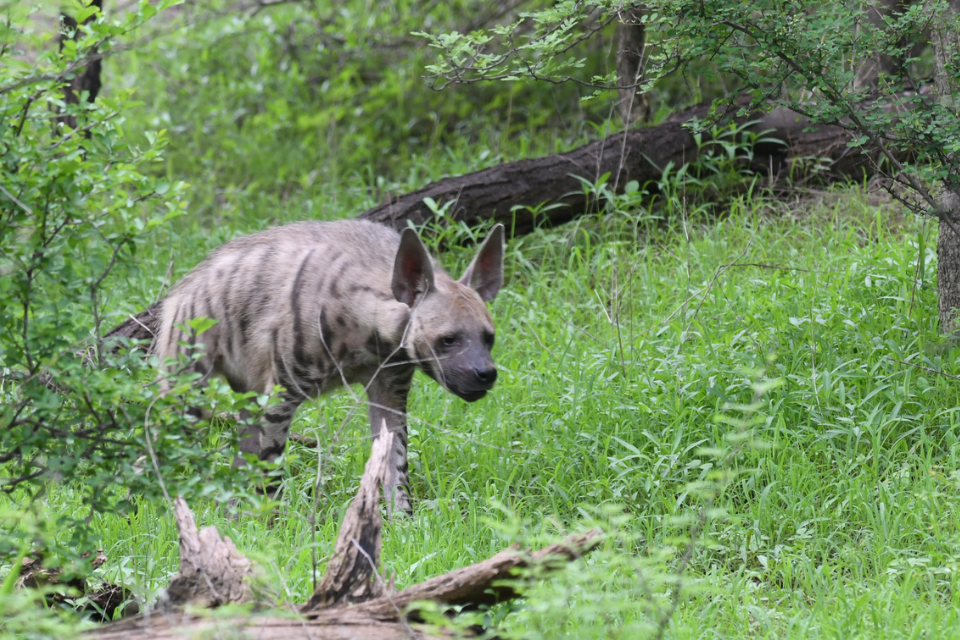- September 10, 2025
Safari Etiquette: How to Respect Wildlife and Stay Safe in Jhalana
Why etiquette matters more at Jhalana
Jhalana Leopard Reserve sits within Jaipur city, making it one of India’s most accessible places to see wild leopards. Recognized as India’s first leopard reserve, it stays open year-round, including the monsoon—rare for Indian wildlife parks. That convenience comes with responsibility: the habitats are close to neighborhoods, and animals are used to vehicles yet still 100% wild. Good etiquette keeps you safe, reduces stress on animals, and ensures future visitors enjoy the same privilege.
Unlike big tiger reserves, Jhalana’s tourism zone is compact (about 23 sq km) and holds a healthy leopard population, often quoted at 30–35 leopards with several frequently using the tourism area. Translation: incredible chances—but also a need to behave impeccably so leopards continue to tolerate vehicles.
Quick orientation: Safaris run in morning and evening shifts and specific timings vary by season. Always double-check your permit for exact slot timing.
Book and prepare the right way
- Book official permits. Use Rajasthan Forest Department’s online systems for Jhalana/Amagarh to secure your slot and carry the same ID used during booking. Keep a digital or printed permit ready for gate checks.
- Plan for quiet observation. You’re here to watch, not interact. Carry binoculars and a camera with a telephoto lens; the more you zoom, the less you’ll be tempted to get too close.
- Understand the safety context. Rajasthan parks emphasize strict on-ground protocols after incidents elsewhere. If a vehicle ever has trouble, stay with your guide and follow instructions—backup and rescue procedures are standard practice in the state’s reserves.
The Golden Rules of Jhalana Safari Etiquette
1) Stay seated, stay inside
Never stand up, dangle limbs outside, or exit the vehicle—even for photos. Getting out is unsafe, illegal in safari zones, and may earn fines or a ban. Your guide decides where to stop and how long to wait.
2) Keep noise to a whisper
Speak softly, silence phone notifications, and avoid sudden movements. Loud talk, claps, or playing animal calls push wildlife away and ruin sightings for all. This is a universal best practice across Indian safaris.
3) No feeding, baiting, or blocking
Do not feed or lure animals, and never corner or cut off their path to “force” a better photo. Let the animal choose the distance—you maintain it.
4) Lights out: no flash
Flash can startle animals—especially nocturnal species like leopards—so turn off flash and avoid blinding spotlights unless your guide uses an approved light responsibly.
5) Zero litter, zero plastic
Carry back every scrap. Use reusable bottles; many Rajasthan parks discourage or ban single-use plastics. Dispose of nothing inside the reserve.
6) Follow the guide—always
Your guide knows terrain, animal behavior, and park rules. If asked to move on, lower your voice, or wait, just do it.
7) Drones are a “no”
Assume no drones in protected areas unless you have written authorization. Unauthorized flights in reserves have resulted in heavy fines and equipment seizure—don’t risk it.
Safety first: practical scenarios and what to do
- Close encounter on the track: If a leopard appears near your vehicle, stay calm, remain seated, and avoid eye contact or sudden movements. Wait for your guide’s cue; reversing quietly to give space is common practice.
- Vehicle stops unexpectedly: Mechanical issues can happen. Your guide/driver will call it in and coordinate support; stay put until help arrives or you’re transferred to another vehicle. Rajasthan reserves actively refine such protocols.
- Animal seen near human spaces: In monsoon or after rains, young leopards occasionally wander into industrial or urban edges and are rescued by forest teams. If you ever see wildlife near city limits, don’t approach—alert authorities.
What to wear and carry (season-smart)
Neutral colors (olive, brown, tan), closed shoes, and a light jacket for winter mornings (Dec–Feb). Summers (Apr–Jun) can be scorching; wear airy, long-sleeved clothing, a hat, sunglasses, SPF 30+ sunscreen, and carry plenty of water. Jhalana is open all months, including monsoon (Jul–Sep); pack a rain jacket and dry bag for electronics then.
Essentials checklist
- Government photo ID used for booking
- Soft bottle(s) of water; no single-use plastic, please
- Binoculars (8x/10x)
- Telephoto lens (e.g., 200–500/600mm) or a compact super-zoom
- Spare batteries and memory cards
- Small first-aid kit and personal meds
- Microfiber cloth & dry bag (monsoon)
- Light snacks only if permitted by your operator—never feed wildlife; pack out all waste

Ethical photography in Jhalana
- Distance is respectful. Use long lenses, not proximity, for frame-filling shots. If the animal glances repeatedly, yawns tensely, or tail-flicks while staring, it may be stressed—back off.
- No playback or baiting. Don’t use recorded calls or food to manipulate behavior. It disrupts hunting and resting cycles—especially critical for a crepuscular predator like the leopard.
- No flash, no spotlighting on faces. Low-light shots? Raise ISO, open aperture, and stabilize on a beanbag.
- Mind the vehicle. Don’t block another jeep’s line of sight; avoid leaning out and keep gear inside.
- Be extra careful at denning sites. If your guide suspects cubs nearby, leave immediately to prevent imprinting or disturbance.
How Jhalana safaris flow (and how to be a model guest)
- Gate entry & briefing
Arrive 20–30 minutes early. Present your permit and original ID; your guide will confirm rules: stay seated, be quiet, no littering/smoking, and no alighting. Many of these rules mirror India-wide best practices. - Inside the reserve
Jeep convoys spread out to reduce pressure on any one sighting. If a leopard is reported, guides coordinate to avoid crowding. Patience often produces the most natural behavior—leopards may emerge from scrub or boulders if vehicles are calm and predictable. - Sighting etiquette
Stop at a respectful distance, engines often idling low. Keep voices at a whisper; turn off the camera beep and flash. If a leopard wants to cross, yield. If it approaches (rare), avoid sudden movement; your guide will instruct a slow retreat. - Exit
Hand over any found litter, thank your guide/driver, and use park facilities—not the roadside—to freshen up.
Best times, shifts, and weather realities
Jhalana yields sightings year-round. However, for comfort, most visitors prefer October–March (cooler days, crisp mornings). The reserve’s morning and evening shifts track daylight and change by season—always check the latest schedule on or near your permit date.
Jaipur now offers multiple leopard experiences—Jhalana, Amagarh, and the newer Maila Bagh—underscoring the city’s rising profile in leopard conservation tourism. Regardless of zone, the same etiquette applies.
Traveling with children or elders
Safaris here are guided, seat-belt-free rides over uneven tracks; that’s thrilling but bumpy. Keep children seated between adults, avoid front rails, and brief them about whisper-voices and stillness. Local operators note that safaris are safe for all ages when rules are followed—you know your family best; plan accordingly.
Conservation mindset beyond the jeep
- Skip geotagging specific spots in real time; share generally (“Jhalana”) to reduce disturbance.
- Support ethical operators who respect sighting caps, avoid crowding, and brief guests thoroughly.
- Tip fairly for guides who prioritize animal welfare over risky close approaches.
- Buy responsibly: local crafts, not wildlife products.
- Report concerns (littering, unsafe behavior) discreetly to your guide.
Quick “Don’t Do This” list (pin this!)
- Don’t stand, shout, whistle, clap, or play music.
- Don’t throw food, feed, or try to attract animals.
- Don’t pressure a leopard for a “crossing shot.”
- Don’t use flash or shine lights into eyes.
- Don’t litter; keep cigarette butts and alcohol out of the park.
- Don’t fly drones without written authorization from authorities.
FAQs
Q1) Can I get down from the jeep for a better angle?
No. Getting out is strictly prohibited in safari zones for your safety and to prevent disturbance. Violations can invite fines or bans.
Q2) Are plastic bottles allowed?
Policies evolve, but Indian parks increasingly discourage or ban single-use plastic. Bring a reusable bottle and pack out everything you bring in.
Q3) What time do safaris start?
Jhalana runs morning and evening shifts whose exact timings change with the season. Check your permit and operator communication for your date’s slot.
Q4) Is the park open during monsoon?
Yes. Jhalana is open all year, including monsoon months—another reason it’s such a popular urban wildlife experience.
Q5) Is Jhalana safe for kids?
Yes—if you follow park rules and keep children seated and quiet. Guides and drivers are trained; safaris are routinely enjoyed by families.
Q6) Are drones allowed for photography?
Assume no, unless you have written permission from authorities. Unauthorized flights in protected areas in India have led to fines and seizures.
Q7) What should I pack for a summer safari?
Neutral, breathable clothing; hat; sunglasses; SPF 30+; plenty of water; and a rain cover for gear if there’s a chance of showers. (Monsoon: add a light rain jacket.)
Q8) What if a leopard is seen near city areas?
Do not approach. Inform local authorities or your operator. There have been recent rescues of wandering young leopards at Jaipur’s urban edge—professionals handle such cases.
Final word
A respectful safari is a better safari—for you, your photos, your fellow visitors, and the leopards who call Jhalana home. Keep noise low, distance high, and your eyes open. If you remember just one line: “Observe, don’t interfere.” With that mindset, the reserve reveals its magic.
Disclaimer All images used in this blog are either sourced from public domain or credited to their respective owners. If you are the copyright holder of any image and wish to request its removal or proper attribution, please contact us at [email protected]














